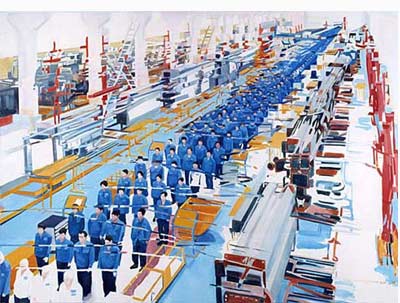Christine Weber


Christine Weber assimiliert in ihren Arbeiten Stills aus Filmen und Bilder, die sie aus den Massenmedien entnimmt.
Fiktionale Szenen vom choreografierten Kampf weiblicher Protagonisten stehen dokumentarischen Material von repressiver Ordnung und Bodrohung gegenüber. Ihre Bilder greifen hierbei den filmischen Ästhetizismus von Gewalt und jenen Voyeurismus auf, der charakteristisch ist für die Berichterstattung über Katastrophen in den Medien. Die Irritation über den in den Bildern sichtbare Moment des Kampfes und der Tragödie, weicht immer mehr einem Befremden über diesen seltsamen Stil der Inszenierung, der Tod und Gewalt als ein dekoratives Element benutzt. Mit Hilfe formaler malerischer Mittel, wie dem Mischen von abstrakten und realistischen Elementen, greift sie in die Inhalte der Bilder ein und setzt einen Prozess der Auflösung in Gang. Diese werden aus ihrer vorherigen medialen Funktion in eine Autonomie überführt, die der Malerei eigen ist. Dadurch, dass sie mittels der Methode des digitalen Zerschneidens und des Zerstörens der Vorlagen und des =superflachen„ Farbauftrags immer wieder auf die materielle Oberfläche ihrer Bilder verweist, werden Fragen aufgeworfen, die sich mit dem Verhältnis zwischen Oberfläche und Inhalt, Abbild und Realität sowie unserem Umgang mit Bildern und der =abbildbaren„ Wirklichkeit auseinandersetzen. Christine Webers Arbeiten loten das Verhältnis zu einer Welt kommerzialisierter und manipulativer Bilder aus, die das Leben mehr und mehr besetzen und unsere Wahrnehmung formen. Sie werden zu einem Konzentrat des Nachdenkens darüber. =Sie spielt damit auf die Problematik an, mit der wir heute angesichts nahezu aller Bilder konfrontiert sind: was wollen wir sehen?„ (Güther Holler-Schuster, active surface, Neue Galerie Graz, 2006, S. 13).
In her work Christine Weber assimilates stills from films and images taken from the mass media.
Fictional scenes of a highly coreographed fight between female protagonists are confronted with documentary material depicting moments of repression and threat. Her paintings embrace the aestheticism of cinema and the voyeurism, which is characteristical for the way the media report on disasters. The irritation of the viewer resulting from the fighting and the tragedy visible in the paintings, increasingly gives way to a greater feeling of amazement over this peculiar style of using death and violence as a decorative element. By applying formal painting techiques, like mixing abstract and realistic elements, Christine Weber intervenes into the substance of the found images and therby initiates a process of disintegration. The media images are transferred from their previous function into a new autonomy, own to painting. By digitaly cutting and destroying the samples and by using the method of a "super flat" colour application she alludes to the material surface of her paintings. She raises the question, about the relationship between surface and content, appearance and reality and enquires the way we handle images and depict reality. Christine Weber‚s work examines our relationship to a world of commercialized and manipulative images, which occupy more and more our life and form our perception. Her paintings can be described as a concentrate of this reflection and examination process. "She alludes to the problem which we are confronted with when face-to-face with allmost all pictures: what do we want to see‰ (Güther-Holler Schuster, active surface, Neue Galerie Graz, 2006, p. 13)
